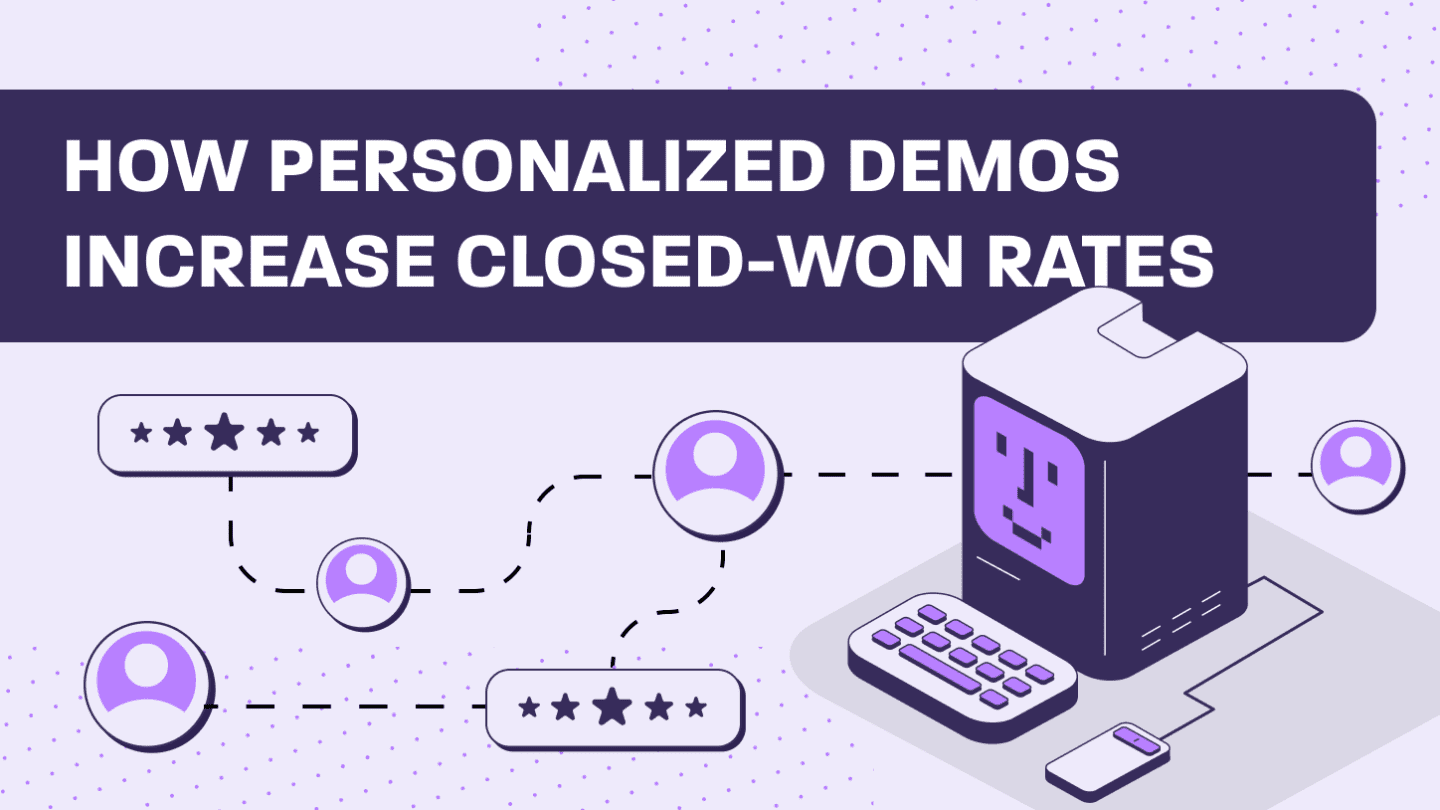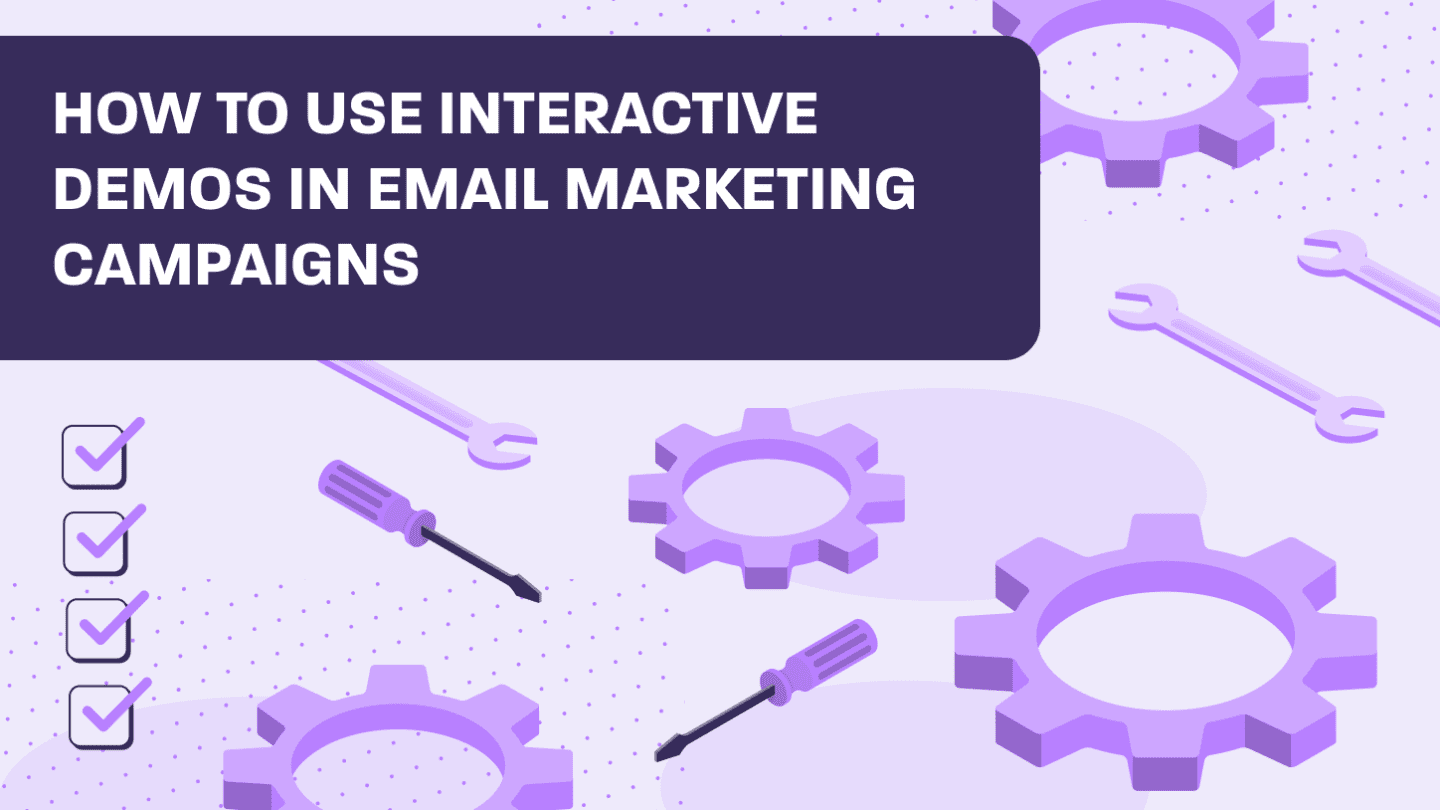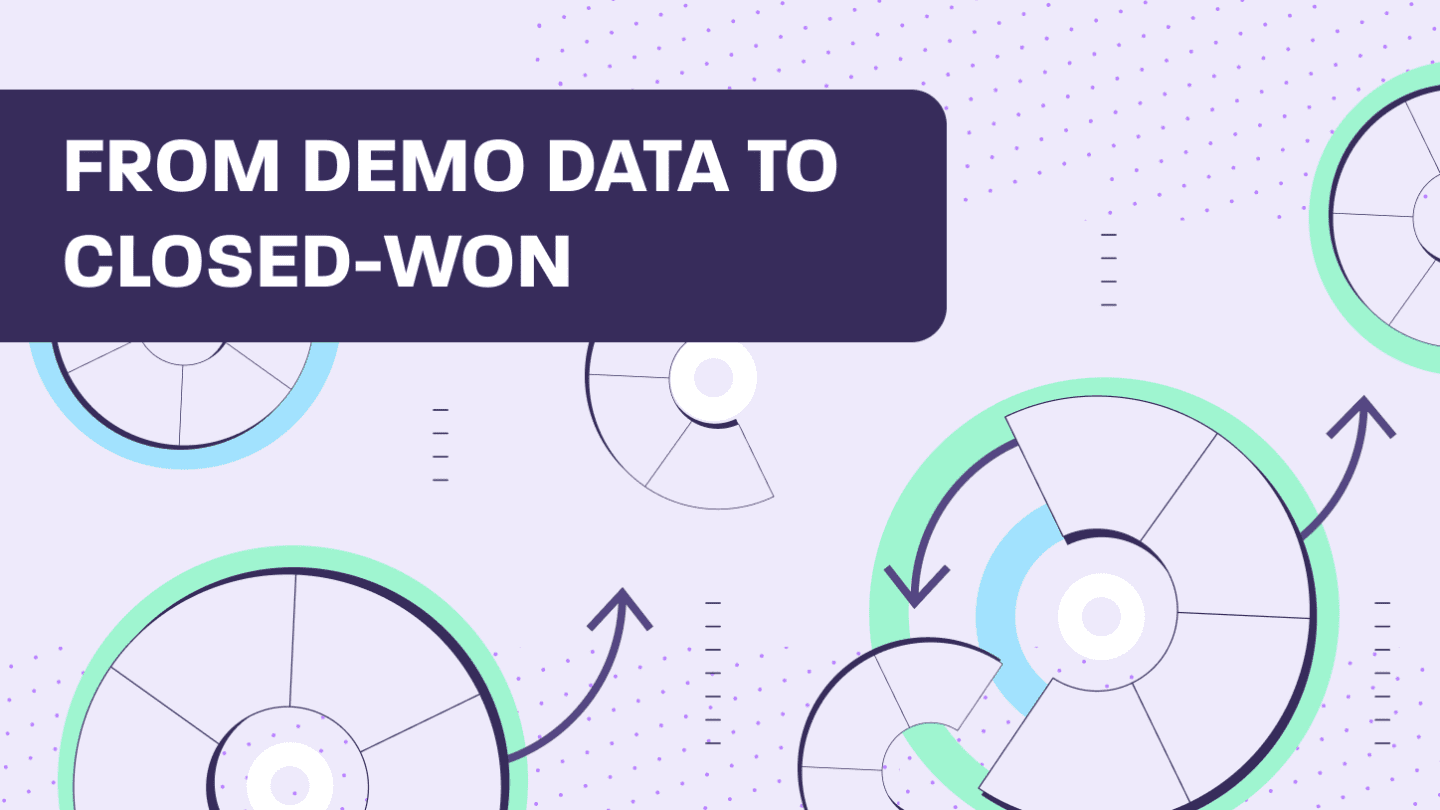Updated on November 28, 2022.
Entering the world of B2B SaaS sales is like moving to a new country: if you want to understand what’s going on, you’ve got to learn the language.
But if all the sales jargon is quickly making you want to pull your hair out or bang your head against the wall, don’t worry.
We at Walnut are here for you. (And BTW so are actual walnuts, which are really good for your brain.)
To boost your sales lingo, we created a handy terminology guide that you can read, reference, and share. Just bookmark this page and come back whenever you stumble upon a new confusing sales term or acronym.
Quick definitions of top sales terms
- B2B: Stands for business to business and refers to businesses that sell products or services to other businesses
- Buying process: The series of steps the buyer will take when they make a purchasing decision
- Product demo: The stage of the sales process where the sales rep showcases the product to the prospect
- SaaS: Stands for software as a service
- Value proposition: A clear explanation of why your customers should want to buy your product
110 common sales terms to increase your vocabulary
A
1. ABC
ABC. A-Always, B-Be, C-Closing. Always Be Closing.
The ABCs aren’t just a Glengarry Glen Ross reference. They’re what reps need to be trying their best to do. Because at the end of the day, every rep has a quota to meet.
However, it’s not easy to always be closing. But there are various closing techniques that can help you turn more prospects into customers.
2. Account-based everything (ABE)
This B2B sales strategy gets the whole team involved in targeting specific high-value accounts. This approach takes account-based marketing to the next level by steering the rest of your company toward the accounts as well.
3. Account-based marketing (ABM)
As opposed to marketing your product to a wide, general audience, this strategy refers to directing your marketing campaign at specific accounts. While this was once a novel idea, now over 80% of B2B companies use this approach.
4. Account-based selling (ABS)
This umbrella term refers to the overall strategy of identifying large, priority accounts you’d like to sell to, and allocating resources to specifically target them. Typically, marketing and sales teams will work closely together to get deals done and customer success will be responsible for onboarding.
As time goes on, the account managers and marketing team will collaborate to try to upsell or cross-sell to these clients.
5. Account development representative (ADR)
This brings us to the ADR, AKA the account development representative.
Often, ADRs will use an outbound sales strategy. Their job is to identify potential customers, qualify leads, and nurture them until they are passed to the account executive. This helps move them through the sales process.
6. Account executive (AE)
AEs are just like us, only with significantly more caffeine jitters.
Your account executive’s job is to be responsible for specific customer accounts, building a relationship with them, and ultimately, convincing them to sign on the dotted line.

7. AIDA
You guessed it, another acronym!
This one stands for Awareness, Interest, Desire, and Action. Each letter represents a different step that an individual goes through during the buying process.
Understanding this information can help sales teams know how and when to communicate with prospects.
8. Annual contract value (ACV)
If you sign a multi-year contract with a customer, you’ll need this metric to track the revenue from your contract per year.
Basically, ACV is the metric that helps you calculate how much an ongoing contract with a customer is worth by averaging and normalizing its value over one year. In addition to multi-year contracts, you can also use ACV to determine the value of monthly subscriptions.
Typically, this metric doesn’t take initial setup or training fees into account.
9. Annual recurring revenue (ARR)
Another key SaaS sales metric you should know is annual recurring revenue (ARR).
Similar to your MRR, which calculates your recurring revenue per month, your annual recurring revenue (ARR) metric tracks your recurring income over a year. By tracking your ARR, you can better monitor your company’s growth year-to-year to measure its progress.
10. Average selling price (ASP)
How much does this product or service usually sell for? That’s exactly what the average selling price (ASP) metric will tell you.
This selling price can be the average within the market in general or within your company. You can calculate this metric by dividing the total revenue earned by the total number of units sold.
B
11. B2B
It’s on to the B’s now.
Standing for business to business, this term refers to businesses that sell products or services to other businesses.
It is important to remember that the B2B SaaS sales process is very different than the B2C process.
12. B2C
Speaking of.
In contrast to B2B, B2C stands for business to consumer and refers to a business that sells directly to consumers rather than other businesses. .
13. BANT
How can you tell if your prospect is the real deal? Great question!
That’s exactly what the BANT qualification methodology was designed to help you determine. When applying BANT, you’ll need to look out for these four elements:
- Do they have the Budget to pay for your product?
- Does your contact have the Authority to sign the deal?
- Do they Need what you’re selling?
- What’s their expected Timeline for completing this purchase?
14. Bluebird
Like we said before, learning about SaaS sales is like learning a new language. And just like any other language, it has its own slang.
A bluebird is slang for an exciting opportunity or sale that pops up unexpectedly, without much effort.
15. Bottom of the funnel (BoFu)
The bottom of the sales funnel is when your prospects are getting very close to completing the deal.
As you get closer to making a deal, you’ll need to address any remaining hesitations and start contract negotiations. This can be done through Q&As, webinars, case studies, and sales demos.
During this stage, you must also remove any barriers that prevent your customer from signing off on your product.
16. Buyer behavior
This term refers to the driving factors behind the buyer’s purchase process, the decision to purchase, and the use of the product. These can include needs and goals, willingness to take risks, environmental factors, and more.
By understanding why and how people decide to buy a product as well as why they are loyal to certain brands can help teams boost their new customer acquisition.
17. Buyer enablement
In a nutshell, buyer enablement is the process of providing buyers with information and support to make the buying decision as easy as possible.
This approach isn’t focused on just closing deals. Instead, it’s about simplifying the buying process and giving buyers what they need to understand how your product can address their specific pain points.
18. Buyer persona
A buyer persona is a detailed description of your ideal customer based on market research and data about existing customers.
To pinpoint who your ideal customer is, use market research and track your existing customers to narrow down the most common or ideal characteristics of your buyers. Then turn these traits into a persona to represent your target audience. This will help your marketing team direct their campaigns and your sales team to qualify leads.
19. Buying criteria
To put it simply, buyer criteria is all of the factors that go into a prospect’s decision to take the plunge and buy your product.
This can be everything your customer needs to know about your product or service before buying, for example: what it is, why it’s needed, what it costs, etc.
20. Buying intent
Buyer intent is the lengths your customer is willing to go to purchase your product. Typically, this is measured over a particular period of time like over the next 6-12 months.
How can you nail down buyers’ intent? Determine your prospect’s intent to buy based on his or her consumption of your content, site visits, and communication.
21. Buying process/adoption process
The buying process is the series of steps the buyer will take when they make a purchasing decision.
But wait, how is this different from buying criteria? Glad you asked!
While the buying criteria is what goes into the decision, the decision process focuses on how that purchase is actually made and what follow-through is involved. This can be an information search, weighing the competition, and post-purchase evaluation.
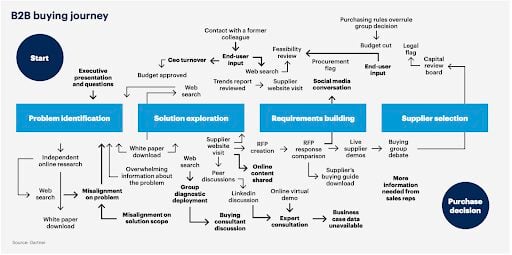
22. Buying signal
Get a clue!
A buying signal is an explicit or subtle clue that the customer is ready to purchase. These signals can be anything from behavioral signs to different data.
C
23. Challenger Sales model
Based on Matthew Dixon and Brent Adamson’s book The Challenger Sale, the Challenger Sales model encourages salespeople to emulate “challengers,” one of five types of sales reps.
Challengers are the ones who provide a new perspective to prospects by understanding what they want, need, and value. They also get sales done by making sure to control the process.
24. Churn rate
Nobody wants to say goodbye to a customer.
The dreaded churn rate refers to the percentage of customers who cancel their subscriptions or stop their business with your company. Calculate your churn rate by dividing the number of customers you lost by your total number of customers, and then multiply this by 100.
25. Click-through rate (CTR)
This is a biggie for any marketing team.
In essence, CTR is the percentage of people who click on your call to action compared to the total number who saw it. This metric is calculated by dividing the number of clicks by the impressions.
26. Closed opportunities
This term refers to closed-won opportunities, (the good kind) where the sales rep closes a deal with a sale, as well as to closed-lost opportunities, (the bad kind) where the deal was closed without one.
27. Closing ratio
This is the percentage of prospects who closed deals in comparison to your total number of leads. Many teams track this sales metric to determine how well they are performing.
Learn more about other sales benchmarks you should be tracking.
28. Cold calling
Cold calling is when a rep will call a prospect without ever having interacted with them prior. This is one of the techniques that sales teams will use to gather new leads as part of its outbound sales.
29. Commission
All reps have one thing in common: they’re always trying to grow their commissions.
In short, a commission is the compensation a sales rep gets when they successfully close a deal.
30. Consumer
Often used interchangeably with “buyer” the consumer actually refers specifically to the one who ultimately uses the product or service. The consumer may or may not have been the one to purchase it.
31. Content
Content is king!
But what exactly is content? It’s any material used to engage with potential buyers, including text, images, videos, interactive product demos etc. GTM teams should leverage different types of content at different stages of the sales cycle.
32. Content management system (CMS)
In essence, a CMS is a software that helps businesses create and edit digital content, like Salesforce or Hubspot.
33. Conversion path
This refers to the “events” on your website that will help you capture leads.
In the most basic terms, a conversion path will have a call to action (CTA) that will go to a capture form. A user will then be redirected to a “thank you” page where the user will get the content you’re offering. In exchange for your content, the user will need to give you their contact information.
34. Conversion rate
This metric is a biggie for sales teams.
In short, it’s the rate of leads who convert to buyers.
35. Cross-selling
Cross-selling is the act of selling an additional product or service in addition to the one that was initially intended to be purchased. This can take place either at the time of the initial sale or after.
36. Customer acquisition cost (CAC)
To keep their doors open, companies need to attract new customers. So, how much will it cost to bring in these customers?
Customer acquisition cost (CAC) is the total cost of acquiring a new customer. You can calculate it by adding up your marketing and sales expenses and dividing it by the number of sales you closed.
37. Customer lifetime value (CLV)
Once you’ve attracted a customer, you’ll likely want to know how much they will be worth to you throughout the entire relationship.
This is exactly what customer lifetime value (CLV) will tell you. The formula for CLV is (ARR x Average length of contract in years) – CAC.
38. Customer relationship management (CRM)
CRMs can help your business track and log all the interactions and experiences you have with your customers. They can also help you with targeted marketing, obtaining customer feedback, sales tracking, and more. Common CRMs that GTM teams use are Salesforce and HubSpot.
D
39. Decision-maker
When referring to sales, the decision-maker is the person in the company who has the authority and ability to complete the purchase. For reps, this is the person to seek out during their interactions with the company.
40. Demand generation
The marketing process of generating demand and hype for a product or service to gather high-quality leads.
41. Demo follow-up email
A demo follow-up email is an email that a rep sends to a prospect who they have presented a product demo to. Unlike the demo request email template you would use for scheduling a demo, the demo follow-up email will usually include a summary of what was discussed during the demo and will help continue the conversation post-demo.
The purpose of these emails is to move prospects closer to the end of the sales cycle.
42. Discovery call
Your discovery call is the first call with a potential buyer where the seller can learn about the prospects’ needs, qualify the lead, and build rapport. When demand gen is done right, it can help a company’s messaging carry more weight.
43. Drip campaign
A series of automated emails that are sent over an extended period and based on actions by the prospect in the hopes to move the lead through the marketing funnel.
E
44. Enrichment
Lead enrichment involves finding and adding information to the lead record to help you speed up the lead qualification process. This information could be company or contact data.
45. EOM, EOQ, EOY
These commonly thrown around acronyms stand for end of month, end of quarter, and end of year.
F
46. FAB
The FAB selling technique is all about understanding and addressing the needs of the customer.
As part of this strategy, there are three aspects of your product you need to explain to the prospective customer:
- Features: What it does
- Advantages: Why those features are important
- Benefits: How it’ll positively impact your life
47. Feature
A specific aspect of your product that can help alleviate a pain point or fill a need.
48. Flywheel
Say goodbye to the traditional sales funnel (that was first introduced in 1898) and say hello to the flywheel sales process.
This concept visualizes the sales process as being like a flywheel: a huge, constantly spinning, momentum-building wheel. The idea is that instead of just looking at your customers as the goal, you should be considering and taking advantage of the impact and influence that happy customers have on finding new customers.
49. Forecasting
The act of predicting your output and future sales based on historical data. This is helpful to make more data-driven business decisions.
Learn everything you need to know about sales forecasting.
G
50. Gatekeeper
The person (think secretary or personal assistant) who stands in between you and the intended recipient, enabling or preventing the passing along of information.
While some try to get around the gatekeeper, it can be more effective to build trust with them so they see you as an ally.
Learn everything you need to know about the different types of prospects you may encounter.
51. Go-to-market strategy
A business’s go-to-market strategy is the overall plan to create and launch a product into the market—making sure the product is useful in function and holds a competitive advantage over the competition.
52. GPCTBA/C&I
In case you want another framework for lead qualification, we’ve got you covered!
This acronym gives reps everything you need to analyze when qualifying your leads:
- Goals: What is the prospect looking to accomplish?
- Plans: What’s in the works to accomplish these goals?
- Challenges: How can they overcome current and future obstacles?
- Timeline: What’s the timeframe for all the above?
- Budget: How much can they spend?
- Authority: Who can champion the deal? Who’s your champion to close the deal?
- Consequences: What does the prospect have to lose by not meeting the goals?
- Implications: What can be gained by meeting them?
I
53. Inbound leads
An inbound lead is one that approaches your brand and expresses interest in your product. Unlike outbound sales, inbound sales happen when prospects react to marketing materials, referrals, or brand awareness and seek out your solution.
Learn everything you need to know about personalizing your inbound sales strategy.
54. Independent software vendor
An independent software vendor builds and sells software that runs on more than one operating system or computer hardware (like Walnut).
55. Inside sales rep
A sales representative who makes sales remotely, usually through phone or email, instead of face-to-face.
Learn more about inside sales.
K
56. Key performance indicators (KPIs)
The main measurable goals you are looking to reach that’ll indicate you are moving in the right direction. Defining a company or team’s KPIs is a crucial way to track progress.
L
57. Land and expand
This sales strategy refers to the process of first aiming to land a deal with a company but then working to expand the scope of the services you provide for this client and increase your revenue.
58. Lead
You’ll hear this term over and over again.
A lead is anyone who has expressed interest in your product but has not yet purchased.
59. Lead generation
Lead generation is the act of acquiring leads.
Businesses can generate leads by having site visitors share their contact information to request a demo, download a white paper, or subscribe to a newsletter or blog.
60. Lead nurturing
Once your business can contact the leads, you must nurture them until they are ready to buy. You can do this through emails, phone calls, sharing data, and more.
When done right, lead nurturing can help you engage with prospects and make them feel confident about their buying decision.
61. Lead qualification
Not all leads were made equal.
To avoid spending time on tire-kickers who are not likely to buy and overlooking those who are, it’s important to qualify your leads. You can qualify B2B leads by using the BANT or GPCTBA/C&I framework.
Even if you have to disqualify a lead, that’s okay. Mallorie Maranda, the VP of Sales at WorkRamp, told us, “If you’re disqualifying deals quickly and only focusing on the people who really see the value of your product, you’re going to grow your deal size because you’re focusing your energy in the right place. You’ll be successful.”
62. Lead scoring
A lead qualification tactic that applies a relative score to each lead based on the perceived value that they can bring to the company.
63. Lifecycle marketing
This marketing strategy stresses the importance of not looking at the deal signing as the final step. Instead, it works to turn your prospects into customers and then into advocates for your business.
64. Lifetime value (LTV)
Your customer lifetime value measures the amount of money a specific customer (or an average customer) will pay your company during their lifecycle with you.
With this metric, businesses can gain useful insights that can help them create pricing plans, optimize buyer retention, and determine how much they can afford to spend on acquiring new customers.
65. LTV:CAC
This crucial metric compares the cost of acquiring a new customer, or the customer acquisition cost (CAC), to the customer’s lifetime value (LTV).
M
66. Marketing qualified lead (MQL)
The leads you determine to be more likely to purchase based on their engagement with your marketing content are called your MQLs. Once the marketing team reviews these leads, they are passed on to the sales team.
67. Middle of the funnel (MoFu)
The middle of the sales funnel, or MoFu, if you prefer. At this point, your leads are usually researching a solution for their pain points and needs. Your goal in this stage is to nurture your leads to become more comfortable and ready to buy.
68. Monthly recurring revenue (MRR)
In the world of SaaS sales, you’ll need to understand how much money you’re bringing in per month. That’s where your MRR comes in.
By keeping track of your MRR, you can make accurate measurements regarding cash flow health, help forecast growth, and plan your budget.
69. Multi-threading
When selling a product or SaaS to a larger company, you’ll likely need to speak to several individuals and decision-makers within the organization. This type of deal is referred to as sales multi-threading.
N
70. Net promoter score (NPS)
This metric tracks your customers’ overall satisfaction by rating their willingness to promote your product or service to another customer from 1-10. You can learn this by providing surveys.
O
71. Objection
A sales objection is when the prospect expresses reservations or challenges the need for your product. Learning about what is leading to the objection and techniques for objection handling is a huge part of making successful sales.
72. Onboarding
Just because the prospect signed on the dotted line doesn’t mean your work is done!
The SaaS customer onboarding process is the step immediately after making the sale: getting your customer up and running with your product or service.
73. Opportunity
An opportunity is when a sales rep is working on closing a qualified lead.
74. On-target earnings (OTE)
This refers to the compensation that a sales rep expects to receive if they reach their performance goals. This includes their base salary as well as commissions.
75. Outbound sales
Outbound sales is the process of reaching out to cold leads and pitching. As part of their outbound sales strategy, sales pros can use cold calling, cold emails, or other forms of communication, like LinkedIn messages or Facebook.
P
76. Pain point
This is the challenge or problem that the prospect is struggling with and looking to find a solution for. The marketing and sales teams should be focusing on finding the pain points among potential customers to explain how your product can provide solutions.
77. Performance plan
The plan given to an underperforming sales rep in order to increase output. Having a performance plan helps sales teams meet specific goals and lets team leads provide feedback and advice. This is also sometimes referred to as a “Performance Improvement Plan (PIP).”
78. Presales
Presales is a process that’s used to effectively educate a well-informed audience.
Presales teams are usually familiar with both the audience and the product, so they are in an expert position to provide buyers with exactly what they need to see in order to close the deal. They will usually do this by creating trials or software demos that prove the product is a worthy choice.
Learn more: What is presales?
79. Point of contact
The contact within the company you’re interacting with is your point of contact.
It is important to remember that your point of contact isn’t always the final decision-maker. That said, you can use your point of contact to get in touch with the appropriate stakeholders.
80. Positioning statement
A sales rep will use positioning statements at the beginning of a sales call to get the conversation started and steer the topic toward the prospect’s pain points. The intent of this is to eventually explain how your product can provide solutions in a way that your competitors can’t.
81. Product qualified lead (PQL)
As opposed to an MQL or SQL, a PQL is a promising qualified lead who has actually tried out and used your product through a free trial, freemium model, or other first-hand experience with your product.
82. Profit margin
This is arguably the one of the most crucial business metrics out there.
Profit margin measures the amount of profit a company earns after all is said and done. You can calculate it like this: (total revenue – total expenses ) / total revenue.
83. Proof of Concept (PoC)
A proof of concept is a demonstration of a particular idea or product. The purpose of a PoC is to see if the idea will work as expected.
84. Prospecting
Prospecting is the process of searching for, screening, and gathering potential leads for outreach and taking them through the sales funnel. The end goal is to turn these prospects into paying customers.
85. Puppy dog close
“Puppy dog close” lets your customer use the product for free and with zero obligations until he or she undoubtedly falls in love with it and won’t want to say goodbye. (Like someone who takes home a puppy for a few days and ultimately can’t give it back.)
Q
86. Qualified lead
Any lead that expresses interest in learning more about your product or moving along the sales process while meeting specific criteria decided upon by your organization. Your criteria can depend on the prospect’s industry, size, location, and more. A lead can be qualified through the marketing team (MQL), or further down the sales pipeline by the sales team (SQL).
87. Quota
The number of sales or the amount of revenue a rep needs to make over an allotted period.
Using the right software tools, like demo experience platforms, reps can provide prospects personalized demo experiences that will help them meet their quotas.
S
88. SaaS
SaaS (pronounced like sass) stands for software as a service. Some examples of SaaS companies include Walnut, Dropbox, Hubspot, Salesforce, and many more.
89. Sales champion
Everybody needs a wingman. And the sales champion is your guy (or gal).
Your sales champion is the person within the company who is convinced of the need for your product or service and then argues on your behalf to the other decision-makers.
90. Sales demo
Your sales demo, or product demo, is the stage of the sales process where the sales rep showcases the product to the prospect. Whereas they were once limited experiences and prone to embarrassing product demo fails, now businesses can use demo experience platforms like Walnut to create foolproof interactive demo experiences.
91. Sales development representative (SDR)
Also known as a business development representative (BDR), the focus of an SDR is on lead qualification, outreach, and prospecting.
92. Sales enablement
If you want sales teams to blossom, you have to provide them with water, sun, and other basics, like software, tools, and resources.
And these tools and other resources are what we call sales enablement.
93. Sales funnel
A visualization of the sales process in the shape of a funnel, your sales funnel consists of the various steps a prospect needs to take to convert. These include awareness, interest, consideration, intent, evaluation, and purchase.
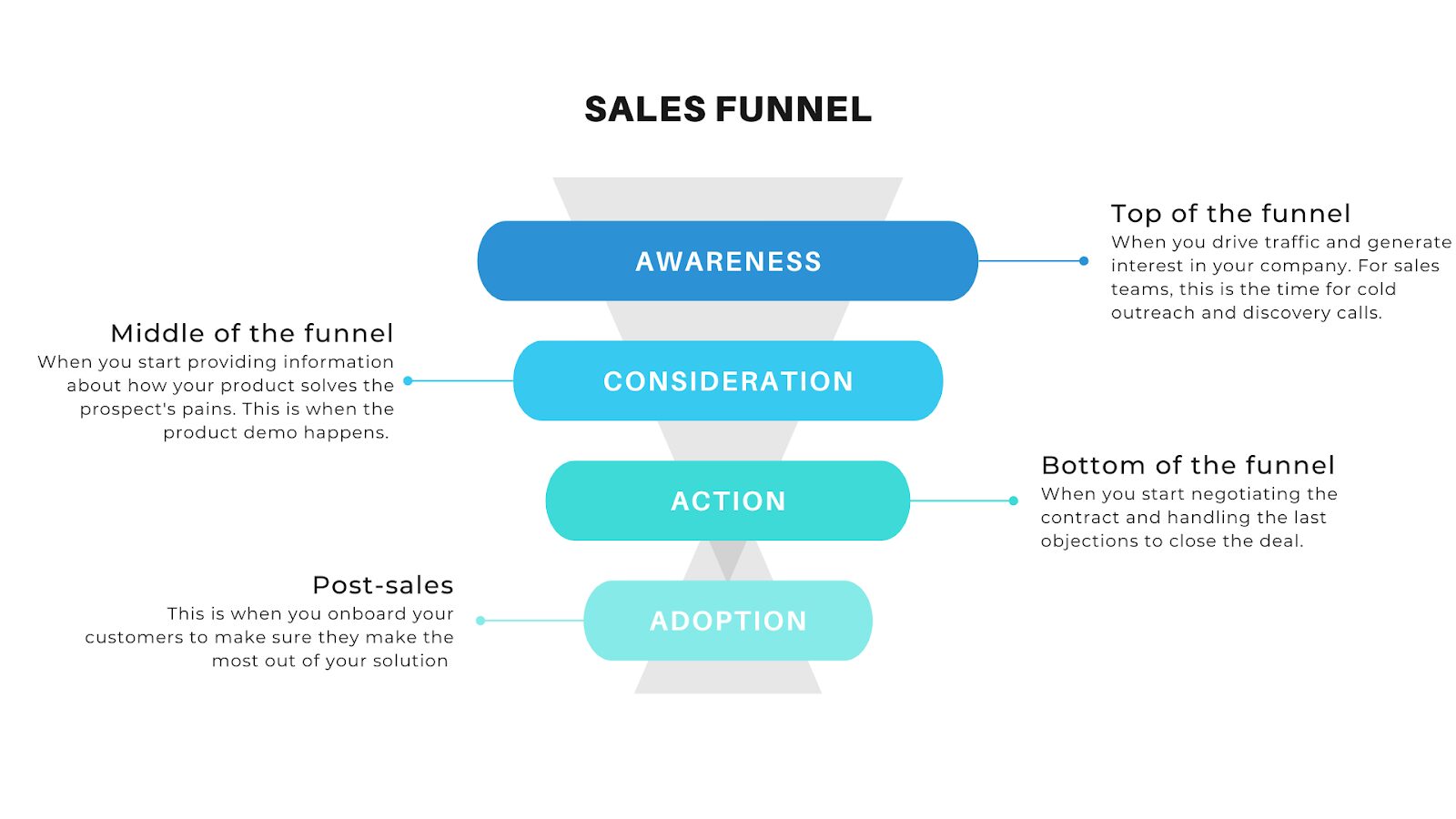
94. Sales methodology
A sales methodology is the overall philosophy, principles, and values that your team is using to generate sales. Sales teams will often be trained and motivated to use specific methodologies.
Some of the most popular sales methodologies include SPIN selling, the Challenger Sales model, Conceptual Selling, Gap Selling, Sandler Selling, MEDDIC, and solution selling.
95. Sales pipeline
A sales pipeline is a way to track the multi-step process of prospects who are converting into buyers. Having a clear pipeline helps sales teams track the stages of each prospect and their overall progress as a group.
96. Sales qualified lead (SQL)
Unlike the MQL, this prospect has also been qualified by the sales team and is, therefore, ready to be passed to the account executive to (hopefully) close the deal.
97. Service level agreement (SLA)
A SaaS company’s SLA usually refers to the agreed-upon technical support resources the organization will provide to its customers.
Your marketing and sales team may also have an SLA to determine each role’s expectations and desired output. The marketing SLA will usually consist of the quantity and quality of leads the team brings in while the sales SLA will dictate the frequency and effort the team puts into each lead.
98. Smarketing
When your sales and SaaS marketing team work together in sync and are so aligned they become one word.
(MIC DROP.)
99. Social selling
The increasingly popular SaaS social media strategy of using social media to make a sale. When done right, it can help sales teams develop stronger connections with prospects.
100. Solutions engineer
As part of the presales process, a solutions engineer supports sales by developing and presenting product solutions to clients. To do this, SEs work right alongside sales teams to create product demos, proof of concepts (PoCs), and custom software solutions. You can think of them as being like the technical support for the sales process.
101. Solution selling
Solution selling is a common B2B sales methodology that encourages sales reps to locate the pain points of the prospect and then develop and propose solutions using your product.
102. Sound bite
A sound bite is a phrase that sales pros will use to respond to and handle an objection from a prospect.
103. SPIN selling
SPIN selling is a popular B2B sales methodology that requires you to create a customer-centric sales process by asking your potential customers questions about these four elements:
- Situation: What’s the prospect’s current situation?
- Problem: Do they have any specific pain points?
- Implication: What impact do these pain points have on their business?
- Need-payoff: How can your product provide a need?
T
104. Tire-kicker
This is an industry term to refer to those people who seem like they may be interested in buying but then never do. Try to avoid these time-wasters by making sure from the outset that the prospect has the capabilities and budget to buy your product.
105. Top of the funnel (ToFu)
The top of your funnel is the widest, aiming to raise awareness of your product among a broad audience of potentially interested people.
U
106. Unique selling point/proposition (USP)
What sets your business apart? What do you have that your competition doesn’t? This is your unique selling point (USP).
107. Upselling
This sales strategy aims to get your prospects to choose a bigger product than they initially intended to buy.
For example, you might say: “For just a few more dollars a month you can get all of these bonus features.”
V
108. Value proposition
A clear explanation of why your customers should want to buy your product. You’ll want to show how your product will address prospects’ specific needs and eliminate all of their pain points.
W
109. Weighted sales pipeline
A weighted sales pipeline is a type of sales pipeline where prospects are evaluated by how likely they are to close the deal based on where they are in the sales funnel.
110. Whale
Every sales rep would love to reel in a whale. In sales lingo, a whale refers to a prospect with a huge potential for the company. But alas, whales are rare and hard to grab.
Using interactive product demos to enhance your SaaS sales strategy
To nail your SaaS sales strategy, you’ll first need to get the slang down pat.
But there’s something else you can do to give yourself a leg up.
And what exactly would that be? To use interactive product demos throughout the sales process!
When you use a demo experience platform (hint, hint, like Walnut) to create personalized product demos, you can better showcase your product’s value proposition and unique selling point.
(Like how we threw in that sales lingo?)
Because when prospects can visualize how a product will actually make their lives easier, there’s a better chance that they’ll sign on the dotted line.
Recommended reads:
- What’s a Product Demo? The Full Guide for Sales Teams
- Marketing and Sales: The Ultimate Guide to Generate B2B Leads (and Deals)
So, what’s holding you back? If you want to improve your SaaS sales strategy, click that “Get Started” button on the top of the page.

